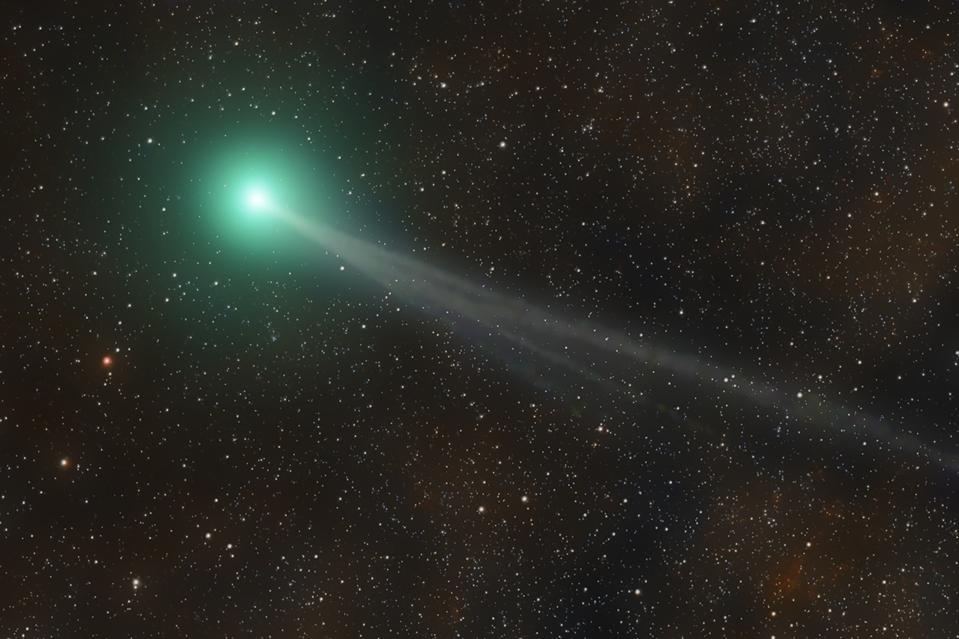Topline
This weekend offers the last best chance to see the two green comets before they’re lost in a brightening moon. On Saturday, Oct. 25, Comet Lemmon (C/2025 A6) continues westward, entering the constellation Serpens in the northwestern sky, while Comet SWAN (C/2025 R2) hangs below the Summer Triangle stars in the south, near Saturn. It’s the best remaining night to catch them before they fade and the 16 %-lit waxing crescent moon begins to bleach the twilight sky.
Key Facts
The brighter Comet Lemmon is visible in the northwest in Serpens, and Comet SWAN in the southwest in Aquarius, about 90 minutes after sunset. Lemmon is moving quickly west of the Big Dipper, near bright Arcturus, while the dimmer SWAN lies beneath the three stars that form the Summer Triangle.
As the moon brightens, this weekend is the last best time to view both comets—though either could still surprise observers with a sudden outburst. Use stargazing apps such as Sky Guide, Stellarium, or SkySafari, or finder charts at In-The-Sky.com. Through binoculars (8×42 or 10×50 recommended), each appears as a diffuse, fuzzy patch with a faint tail. The best views will be had far from light pollution in a Dark Sky Place (or somewhere that looks dark on a light pollution map).
Comet Lemmon was discovered on Jan. 3, 2025, by the Mount Lemmon Survey near Tucson, Arizona, and will reach its closest point to the Sun on Nov. 8. Comet SWAN was found on Sept. 11, 2025, as it looped around the Sun. Lemmon last visited the inner solar system in AD 875 and will return around 3175, while SWAN takes roughly 20,000 years to complete one orbit.
They’re not the only comets making headlines: hidden in the Sun’s glare, Comet 3I/ATLAS — an interstellar visitor from another star system — is racing through our solar system at about 67,000 mph (108,000 km/h).
When And Where To See The Comets
The best time to spot Comet Lemmon and Comet SWAN on Saturday, Oct. 25, is during a 30-minute window starting about 90 minutes after sunset where you are. Both are visible after sunset but in opposite parts of the sky — Lemmon in the northwest, SWAN in the southwest. For New York City, where sunset is at 5:57 p.m. EDT, the ideal time for evening viewing is 7:27-7:57 p.m. EDT. A 16%-lit waxing crescent moon will be low in the southwest, setting early, so both comets benefit from dark conditions before the moon brightens later in the week.
How To Find Comet Lemmon
Distance from the sun: 59.2 million miles (95.2 million kilometers)
Distance from Earth: 57.1 million miles (91.9 million kilometers)
After sunset on Saturday, Oct. 25, look for Comet Lemmon above bright star Arcturus low on the northwest horizon. Trace the stars in the Big Dipper’s curved handle and go in an “arc to Arcturus.” Now go in a right angle to the next bright star, Rasalhague, the brightest in the vast constellation Ophiuchus. Its height above the horizon varies by location, but from New York, the comet will appear about 20 degrees above the northwest horizon at 7:27 p.m. EDT and will gradually sink as twilight deepens.
How To Find Comet Swan
Distance from the sun: 99.7 million miles (160.4 million kilometers)
Distance from Earth: 26.9 million miles (43.3 million kilometers)
Blue-green Comet SWAN will be visible in binoculars on Saturday, Oct. 25, low in the south-southwest after sunset. It will be in Aquarius, above the “Teapot” asterism of Sagittarius, and below and to the left of bright Altair in the Summer Triangle. For mid-northern observers, another easy method is to look halfway between Altair and the bright star Fomalhaut. From New York, SWAN will be about 43° high at 7:27 p.m. EDT before slowly sinking toward the horizon.
Check my feed every day this month for a daily “comet tracker” with finder charts and tips for viewing Comet Lemmon and Comet SWAN from mid-northern latitudes. Also read How To Photograph The Green Comets, Best Stargazing Apps For Finding The Comets and 25 Dark Sky Parks In The U.S. To See The Comets.

